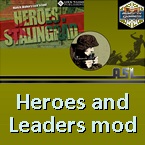asl3d
Posts: 6531
Joined: 2/6/2017
Status: offline

|
To the look of the success of the SU-152, the Russian engineers decided to conceive a similar vehicle on the basis of the chassis of the IS tank of which the production had just been launched to the ChKZ. Shortly after the SU-152’s deployment, the NKTP ordered design teams in Chelyabinsk, in cooperation with the Mechanized Artillery Bureau, and General F. Petrov, to design two new heavy assault guns based on the IS-2 hull on May 25th, 1943. The development for this tank was undertaken by the famous Joseph Kotin, and G.N. Moskvin as the main designer – the first prototype was ready in only a month.
The ISU-152 was an absolute nightmare for the Wehrmacht. Much like the SU-152, it was capable of blowing Tiger, Ferdinand, and Panther turrets/casemates open. However, what made the ISU-152 inherently better than the SU-152 was its superior armor and towing power. It had three major roles – assault gun, tank destroyer and mobile artillery, which made it one of the most versatile heavy vehicles of the war.
The ISU-152 was endowed with a combat compartment more spacious than the one of the SU-152, wiht a higher superstructure, more rectangular, and also featured less sloped side armor. Thicker frontal and side armor (90 mm instead of 60 mm) did not make the crew compartment any smaller, so there was still space for 20 shells of 152.4 mm for the ML-20S gun. The other main differences between the SU-152 and the IS-152 were that the suspension was lower, and a heavy, two-piece gun mantlet was bolted onto the right of the hull. It underwent factory trials in September, 1943, but a large number of problems with the design was encountered, so the design was reworked. By November 6th, 1943, an order was issued for this tank to be mass produced and it was now known as the ISU-152. Production started in December and replaced production of the SU-152 at the Chelyabinsk Kirovsk Plant. Between December 1943 and May 1945, 1885 ISU-152s were made. When production finally ended in 1947, 3242 vehicles had been produced.
The ISU-152 was hardly a different concept to other Soviet self-propelled guns. It still featured two compartments – the fighting compartment and ammo storage in the front, and engine and transmission at the back. The gun was mounted slightly off-center and could traverse 12 degrees left and right. It had 12 torsion bars, 6 road wheels, rear drive sprockets, and front idlers identical to road wheels, thus making maintenance easier. There were three internal fuel tanks – one in the rear compartment, and two in the fighting compartment. Like most late-war Soviet tanks, there were also up to four external fuel tanks that were not connected to the engine. The howitzer of 152.4 mm ML-20S installed in the superstructure was supplied with 20 projectiles of 152.4 mm. It was protected by the same mantlet that the gun of 122 mm (A-19) of ISU-122. This gun had a range of 8960 m and was coupled with KT-5 sight. This howitzer put to fire 2-pieces rounds, semi-armor piercing and high explosive or to fragmentation. The ML-20S could pierce 120 mm of armor to 1000 m. The armament was completed by a heavy machine gun of 12.7 mm DShK mounted on the roof of the superstructure, supplied with 1000 projectiles. The crew disposed again for its defense of PPS or PPSh submachine-guns and of grenades F-1.
During the production one tried to rearm the ISU-152 while using different pieces as the 152 mm BR-8 with long barrel, the 152 mm BL-10 and the 130 mm S-26. All these attempts not out passed never the stage of the prototype.
All roof hatches were fitted with periscopes, as well as there being two gun sights – a telescopic, and a panoramic ST-10. An intercom was also fitted, and each vehicle had a standard 10R or 10RK radio set. The crew was also given a pair of PPSh-41 sub-machine guns with up to 1491 rounds, as well as 20 F-1 grenades in case they needed to abandon the vehicle in combat. Giving the crew weapons was not at all an uncommon practice. Whilst at first, the ISU was based on the IS-1 hull, it was later based on the IS-2 hull in 1944, which meant that the vehicle had extra fuel capacity, a newer radio, a slightly modernized main gun, mantlet armor was increased, and finally, an AA machine gun was installed in an AA mount. Also, a fourth, round hatch was fitted at the top right of the roof, next to the rectangular hatch on the left-hand side. The later ISU-152 modifications, with newer gun and slightly longer barrel, (4.9 meters), had a maximum range of fire of up to 13,000 meters.

 Attachment (1) Attachment (1)
_____________________________
Semper fidelis
|
 Printable Version
Printable Version





































 New Messages
New Messages No New Messages
No New Messages Hot Topic w/ New Messages
Hot Topic w/ New Messages Hot Topic w/o New Messages
Hot Topic w/o New Messages Locked w/ New Messages
Locked w/ New Messages Locked w/o New Messages
Locked w/o New Messages Post New Thread
Post New Thread